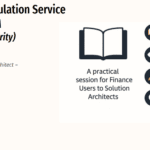
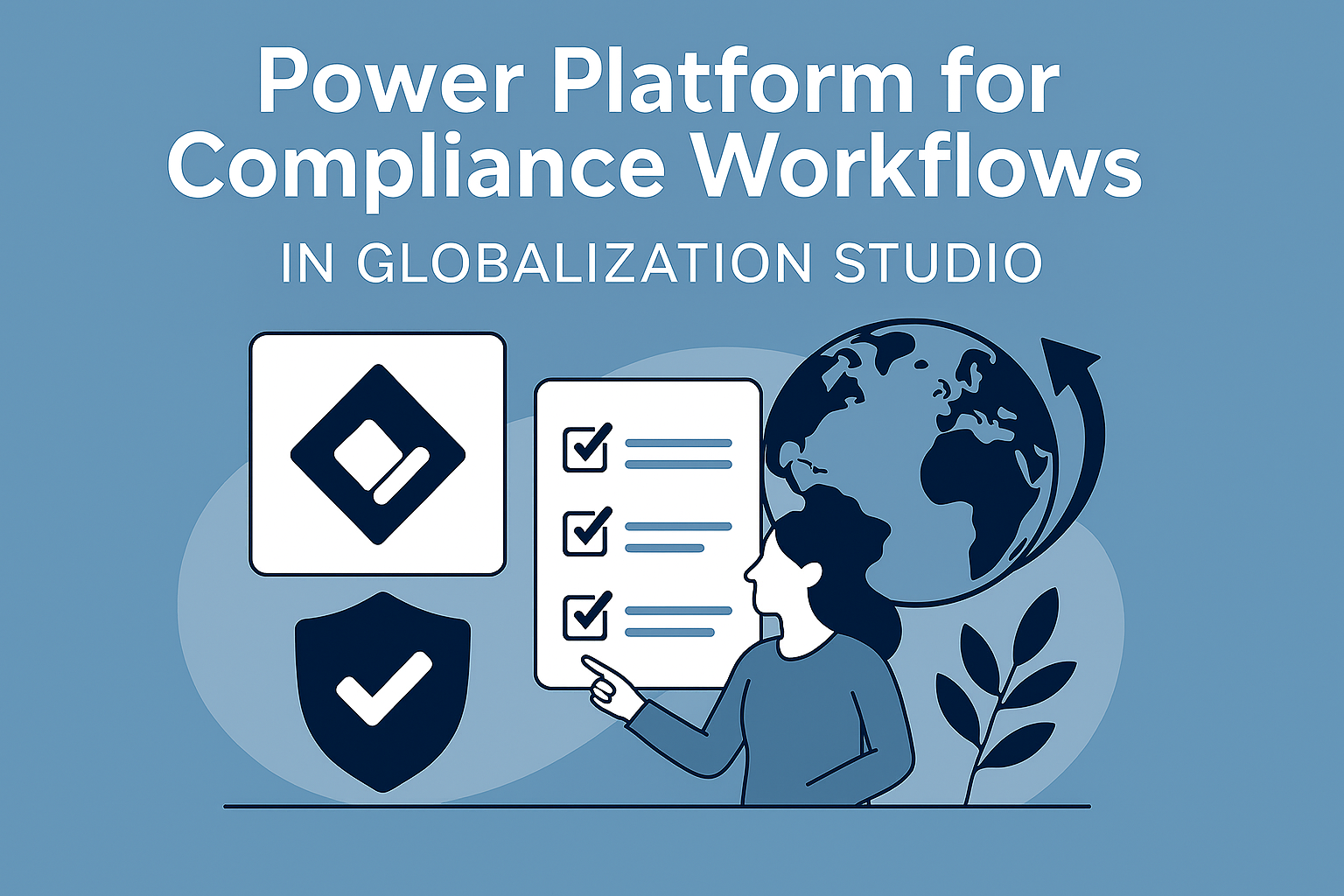
GS523 – Power Platform for Compliance Workflows in Globalization Studio
As businesses scale and compliance obligations grow more complex, automation becomes critical, not just for tax and document submission, but for what happens after.
Globalization Studio in Dynamics 365 provides the core execution engine for tax, document, and electronic invoicing features, but what if you could add dynamic reactions to those outcomes?
That’s where Microsoft Power Platform becomes your compliance co-pilot.
Table of Contents
Toggle🚀 What This Article Covers
In this article, you’ll learn how to:
- Leverage existing data events and submission logs for compliance monitoring
- Use custom alerts and business rules to notify the right people
- Tap into existing and virtual data entities, with no custom code
- Design an architected, modular approach, even without a live demo
⚠️ Note: Configuration screenshots are not included as this guidance is based on a theoretical approach. The concepts explained here are derived from real implementations, but not demonstrated in the current demo environment.
⚙️ Why Combine Power Platform with Globalization Studio?
Think of it this way:
🧠 Globalization Studio → Handles logic and submission
🤖 Power Platform → Reacts, escalates, and communicates
This combination unlocks:
- End-to-end compliance visibility
- Real-time user alerts and case escalation
- Integration with Teams, Outlook, DevOps, SharePoint, and more
🔍 1. Use Existing Data Events & Virtual Entities for Submission Monitoring
Dynamics 365 already produces structured records for:
- Submission logs
- Error messages
- Processing results
These logs can be:
- Read through
Dataverse virtual Entities
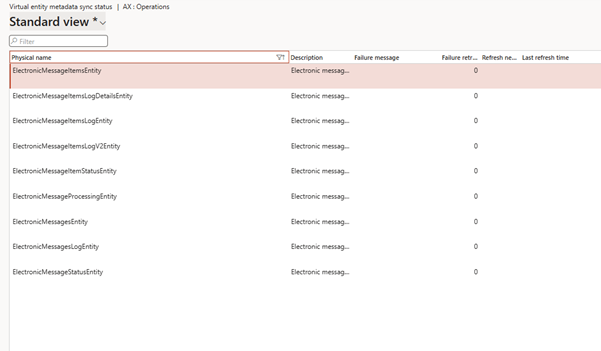
| Entity Name | Description | Typical Use Case | Power Platform Benefit |
| ElectronicMessageItemsEntity | Represents individual message items (e.g., one invoice, one file). | Track submission status of each invoice or document. | Trigger flows for failed items, push Teams/email alerts per document. |
| ElectronicMessageItemsLogDetailsEntity | Detailed technical log for each message item. | Investigate submission errors, failed payloads, or integration issues. | Provide error detail context in Power Automate alerts or dashboards. |
| ElectronicMessageItemsLogEntity | Summary log for message items. | Monitor submission summary per item, including timestamps and outcomes. | Aggregate status history into Power BI for trend analysis. |
| ElectronicMessageItemsLogV2Entity | Enhanced version of message item log with extended schema. | Use in newer ER versions for more granular logging and retry logic. | Compatible with newer solutions; enriches compliance audit reports. |
| ElectronicMessageItemStatusEntity | Tracks individual item statuses (e.g., Created, Processing, Failed, Sent). | Visualize document life cycle through each processing step. | Create workflow rules based on item status changes. |
| ElectronicMessageProcessingEntity | Captures processing step results (e.g., Sign, Store, Submit). | Audit which pipeline steps succeeded or failed for each message. | Identify automation failure points and inform next steps. |
| ElectronicMessagesEntity | Header or parent message grouping related items together. | Manage multi-document batches (e.g., invoice group submission). | Initiate Power Automate flows per batch header for group processing. |
| ElectronicMessagesLogEntity | Log data at the full message (batch) level. | Track message group submission outcomes, response logs. | Correlate batch-level success/failure and integrate with issue trackers. |
| ElectronicMessageStatusEntity | Tracks the overall status of a full message group. | Determine if a full document set was processed successfully. | Condition Power Automate flows to proceed or alert based on group status. |
Data Events
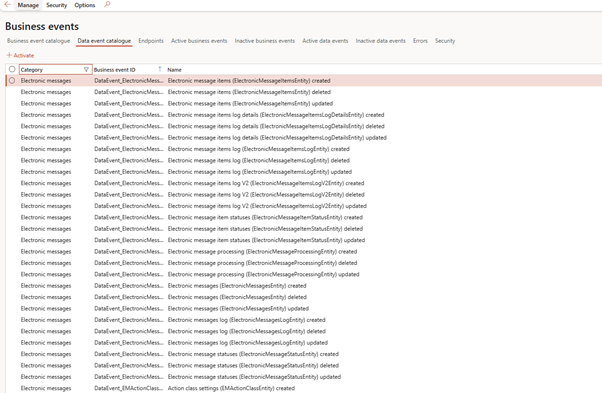
These data events allow you to react to key lifecycle changes in the electronic message framework, such as:
- A new invoice submission starting (created)
- A file being logged, signed, or sent (updated)
- A document being rejected, retried, or deleted (deleted)
These events don’t process the document, they notify you when something important happens, enabling real-time automation, exception handling, and compliance visibility via Power Automate.
🧠 When and Why to Use These Data Events
| Usage Area | How These Data Events Help |
| Compliance Monitoring | Trigger workflows when a document is rejected, fails submission, or receives a status update. |
| Exception Management | Automatically assign failed or rejected items to business users or finance teams. |
| Audit Logging | Log changes to submission lifecycle in SharePoint or Dataverse for audit trail visibility. |
| Status Notifications | Inform internal teams or external partners when a document status changes (e.g., “Sent” or “Failed”). |
| Integration Triggers | Call external systems (e.g., SAP, email gateways, case management) when electronic records are created. |
✅ Best Practices & Recommendations
| Recommendation | Why It Matters |
| Use created and updated events only | These are the most useful for automation; deleted is typically noise unless auditing deletions. |
| Avoid tight coupling to internal tables | Use virtual entities or Dataverse instead of accessing D365 directly inside flows. |
| Log every triggered flow | For traceability and audit, log each triggered business event to a central store like SharePoint or Dataverse. |
| Filter intelligently inside the flow | Not every update means failure, add conditions like Status = Failed before triggering alerts. |
| Disable unused events | Keep the environment clean and performant by disabling business events not relevant to your use cases. |
| Always secure your endpoints | When using Power Automate HTTP triggers or Azure Logic Apps, ensure token or certificate authentication. |
| Use separate flows for Dev, UAT, and Prod | Avoid cross-environment noise; follow standard ALM practices for compliance flows. |
📢 2. Use Custom Alerts to Notify for the changes
📊 Electronic Submission Log Tables
| Table Name | Purpose | Key Field(s) | How It Works | Best Practices |
| BusinessDocumentExecutionResult | Stores the overall outcome of a document submission or pipeline execution. Each record represents one execution run. | Status (e.g., Succeeded, Failed, InProgress) | Created automatically during ER pipeline execution (e.g., electronic invoicing, format transformation, or storage). It logs the top-level result of the pipeline process. | Use Status to monitor success/failure of document runs. Trigger Power Automate flows when Status = Failed. Filter by execution date or legal entity to isolate issues. |
| BusinessDocumentExecutionResultLog | Stores detailed step-by-step messages linked to each execution (e.g., validation result, error, success note). | Message (free text: error message, success logs, validation outcome) | For each execution result, multiple log entries are stored here. These logs capture runtime activity like signing, transformation, storage, or submission response from a government portal. | Always log both success and error messages for traceability. Display Message values in submission audit screens or notifications. Join with Executio |
✅ Use Power Automate to listen alerts use business events , no dependency on X++ or hardcoding.
You can setup alerts directly from Table Browser
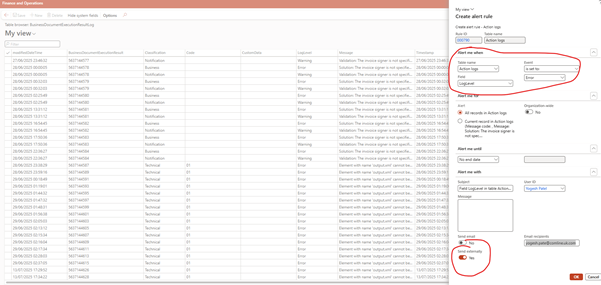
📊 3. Use Existing Data Entities
Dynamics 365 exposes many useful data entities
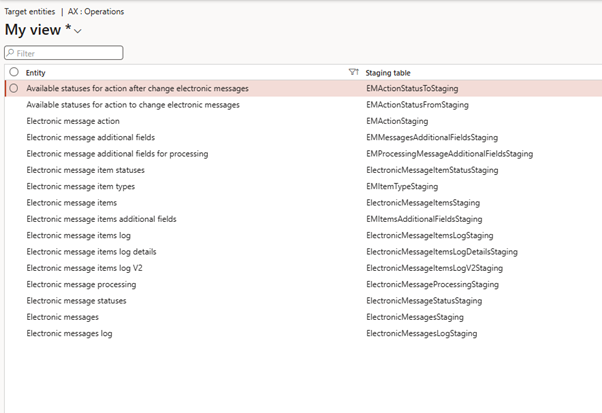
Use data entities for:
- Archival/export
- Reprocessing or data cleansing
- Historical reporting with large data sets
| Scenario | Recommended Entity Type | Why |
| Monitoring submission results | Virtual Entity | Lightweight, real-time view (e.g., failed invoices) |
| Triggering compliance alerts | Virtual Entity | Can trigger Power Automate flows without data movement |
| Bulk error log exports to Excel/Data Lake | Data Entity | Staging tables are optimized for bulk reads |
| Reprocessing or correcting logs | Data Entity | Allows manual data manipulation via staging |
| Audit dashboards (Power BI) | Virtual Entity (for live), Data Entity (for historical) | Mix both , live for dashboard tiles, data entities for trend analysis |
| Custom ALM/DevOps processes | Data Entity | Better control with versioning and import/export scripts |
🔄 Example Compliance Workflows (Conceptual)
| Scenario | Outcome |
| B2G invoice to Spain fails | Auto-alert in Teams and log entry in SharePoint |
| Rejected XML file | Assign a Power Automate task to compliance officer |
| New format version deployed | Trigger a review/acknowledgment by test team |
| Tax override detected in TCS | Notify tax owner for secondary approval |
💼 Real-World Application Scenarios
Even without configuration access, a solution architect can design:
- An event-driven compliance framework
- A scalable notification model with environment separation (Dev/UAT/Prod)
- Modular flows for audit-readiness and governance
“Power Platform gives you visibility. Globalization Studio gives you control. Together, they give you confidence.”
🧠 Best Practices from the Field
| Tip | Why It Matters |
| Use standardized flow names | Easy to trace and maintain |
| Define owner/role per flow | Critical for audits and support |
| Use centralized logging | Avoid redundant alerting |
| Secure all endpoints | Use Azure AD auth, tokens, and IP filters |
| Test in layers | Keep your compliance flows loosely coupled |
🧭 Related Articles
- GS508 – ALM for Compliance Features
- GS514 – Routing and Storage
- GS517 – Logs and Error Management
- GS528 – Archival and Compliance Audit
📘 Coming Up Next
In GS524 – Embedding Business Rules and Exceptions in Globalization Studio, we’ll show you how to take compliance personalization further by embedding dynamic rules directly into your features.
You’ll learn how to:
- Apply applicability rules using context variables
- Add validations in Format Designer to catch errors early
- Control pipeline steps based on customer type, amount, or geography
- Design real-world use cases like B2B vs. B2G logic in Spain
📖 Continue reading: GS524 – Business Logic and Rule Embedding →
🔍 View Full Article in PDF
GS523I am Yogeshkumar Patel, a Microsoft Certified Solution Architect and ERP Systems Manager with expertise in Dynamics 365 Finance & Supply Chain, Power Platform, AI, and Azure solutions. With over six years of experience, I have successfully led enterprise-level ERP implementations, AI-driven automation projects, and cloud migrations to optimise business operations. Holding a Master’s degree from the University of Bedfordshire, I specialise in integrating AI with business processes, streamlining supply chains, and enhancing decision-making with Power BI and automation workflows. Passionate about knowledge sharing and innovation, I created AI-Powered365 to provide practical insights and solutions for businesses and professionals navigating digital transformation. 📩 Let’s Connect: LinkedIn | Email 🚀
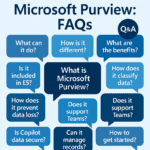
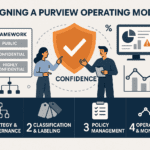
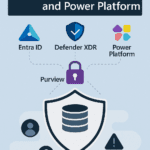


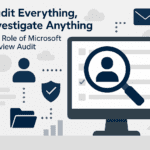

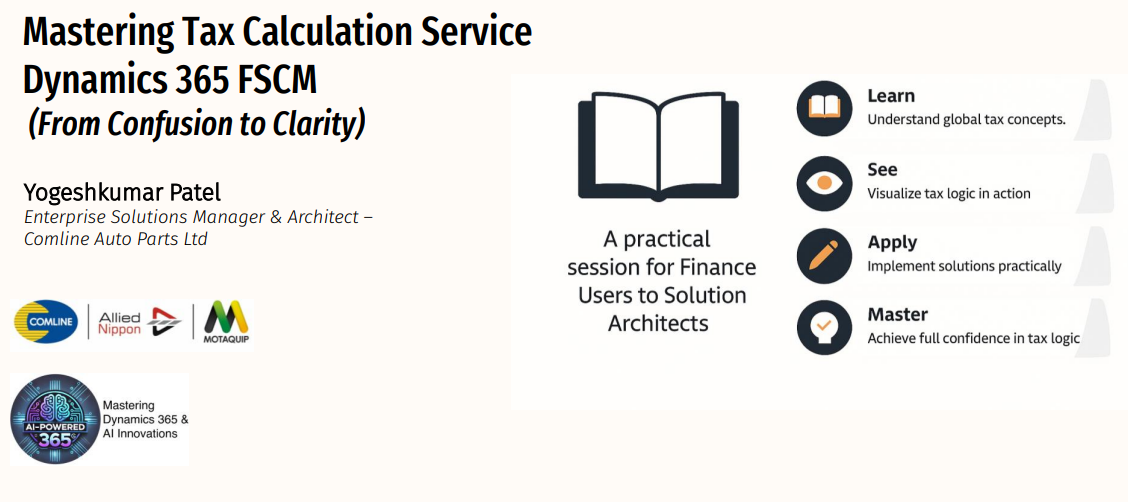
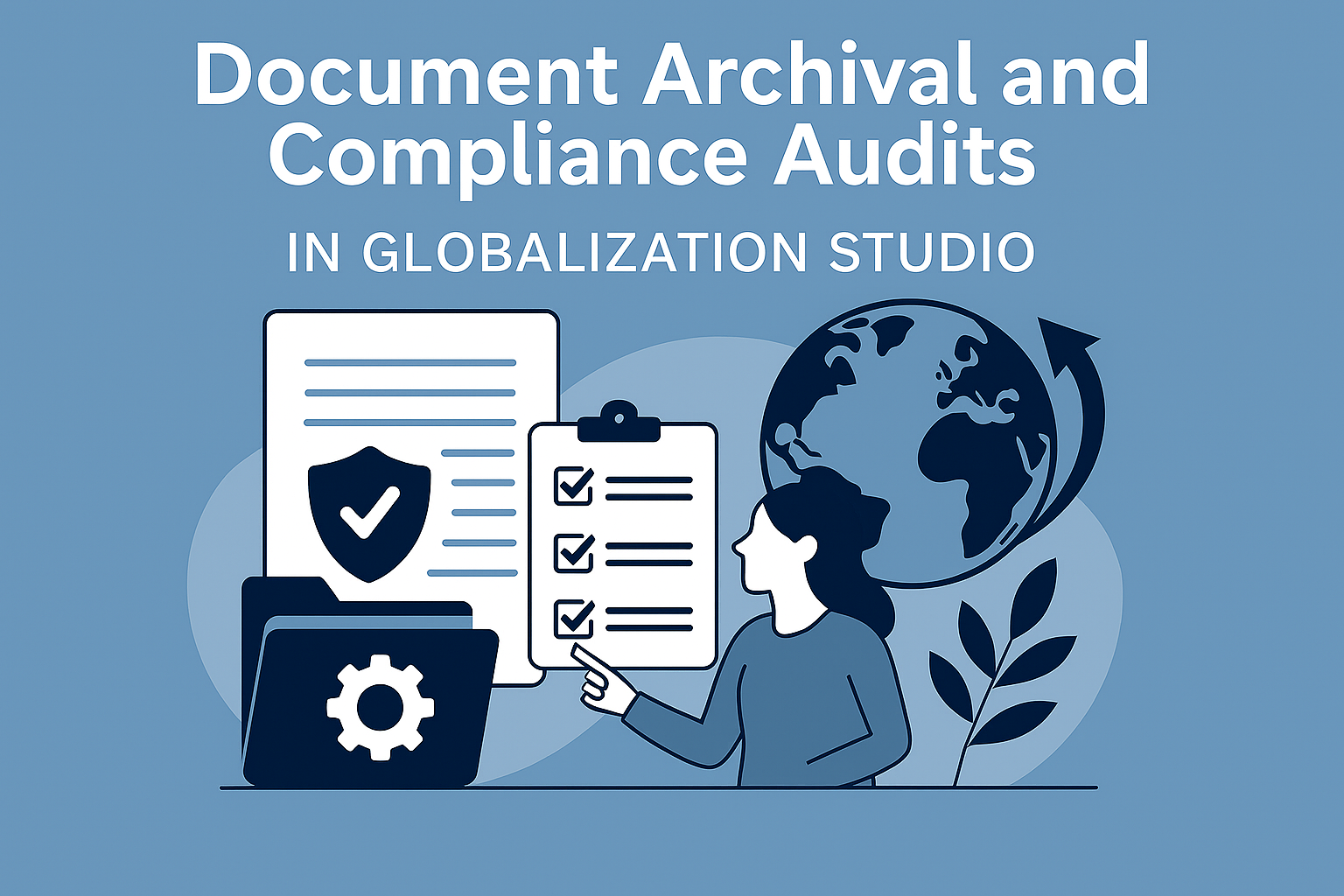
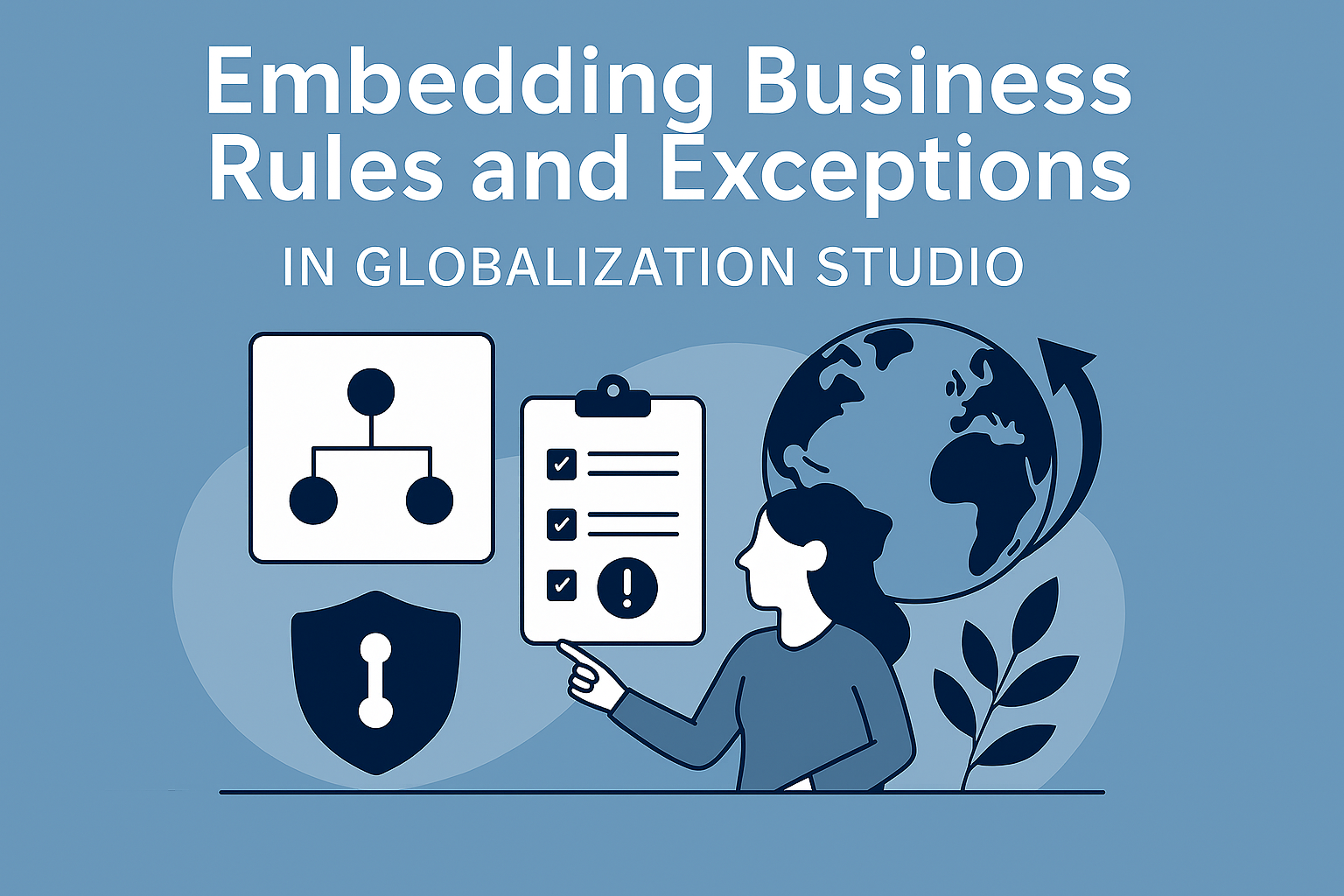










Post Comment